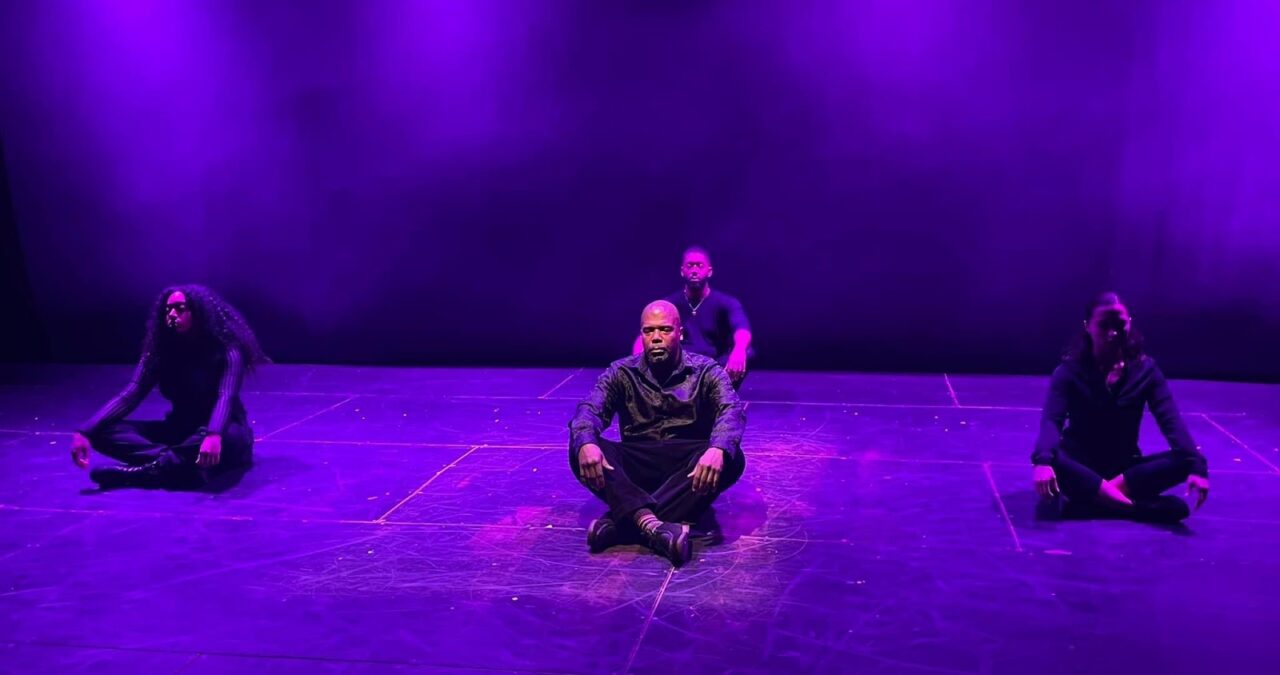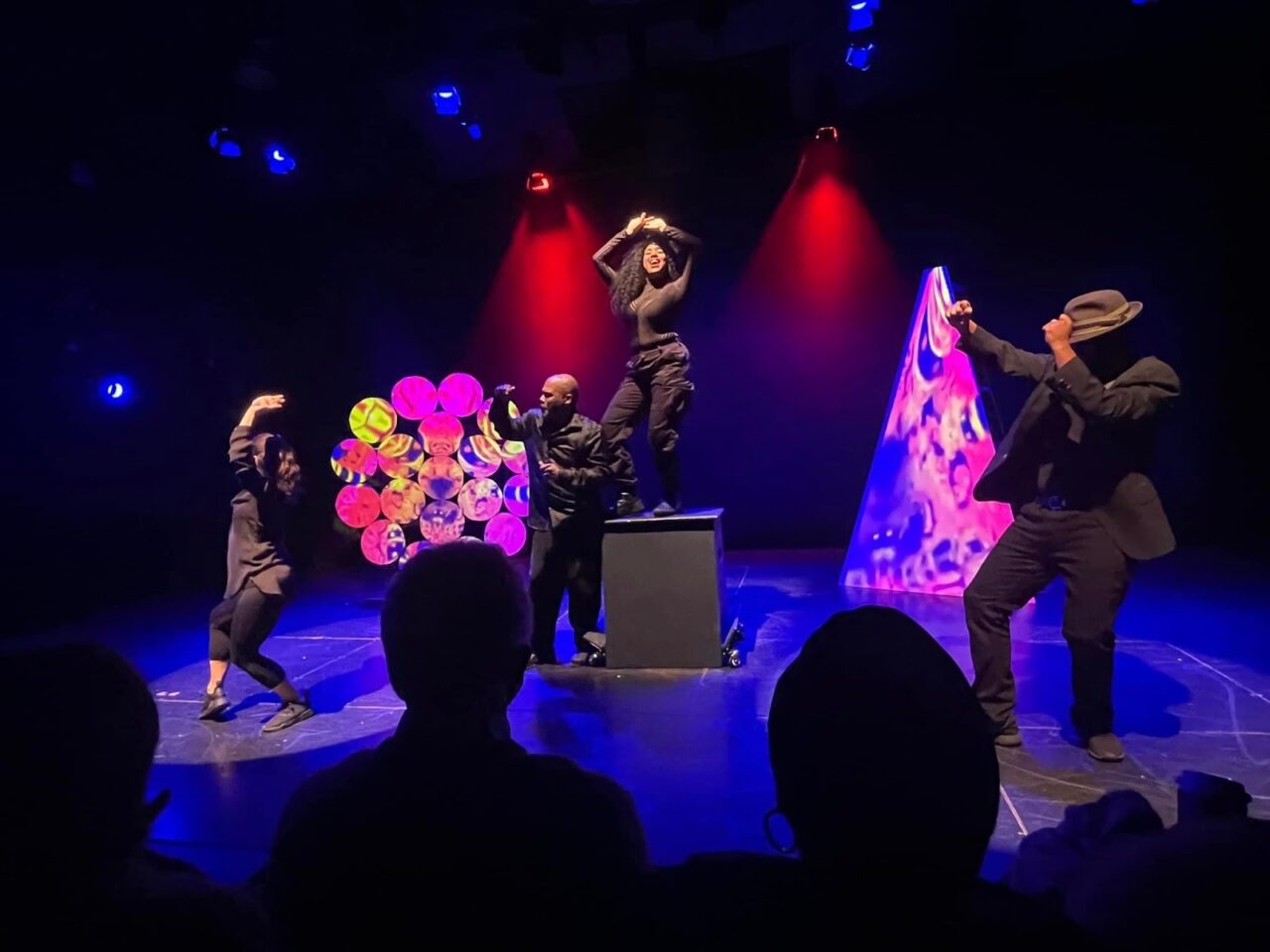
Guest Editor Anjel Newmann was recently a featured performer in Bliss Body, an experimental performance at Everett Theater and School in PVD, along with Christopher Johnson, Ari Brisbon and Grace Colonna. She talked about the piece and its impact with both makers and audience:
“Struggle is a part of it.” In some ways, this is the production. A single line that encapsulates the entirety. This line has become a sort of mantra for our cast. It comes from a longer Bliss Body poem where Christopher Johnson illustrates his journey through meditation, a practice that started 13 years ago. “Seeing Christopher finally being able to talk about his meditative practice instead of talking about his response to racism was such a beautiful growth space for me,” said April Brown, writer and co-director of the Langston Hughes Community Poetry Reading Committee. Brown was in the audience on the last Sunday of our 11-show run. As we reflected, she said that it’s evident that the cast discovered a Divine Practice. “That’s the genius of us having the arts. We actually get an opportunity to show our humanity by singing, dancing, writing, acting on a stage, and being vulnerable, and there’s something about a spiritual practice that involves those same components and pieces.”
April is right. This production is much more than a performance — it’s a journey back to who we were. The creative process is a shovel that helps us uncover and pull out pieces, limbs, fragments of ourselves that were buried deep beneath the sands of time. A cave of wonders. Every rehearsal, we practiced meditation and yoga as a way to teleport into our untapped truths; a place that resides within each of us, like an underwater garden hidden far beneath the surface. Bliss Body was created from that garden. For a year and a half, Creative Director Aaron Jungles and our cast worked to understand the meaning of Bliss.
Two years prior, Everett Company Stage and School, the creators of Bliss Body, dedicated an entire production to exploring trauma, even bringing in a therapist to work with the cast. As the newest edition, the most recent Bliss Body was meant to be a pilgrimage back, away from trauma, but as we danced, sang, meditated, remembered more — there was Christopher’s reminder, “Struggle is a part of it.” April says that there is something about our piece that elevates the “dysfunctional aspects of who we are as people and with our bodies” and that our efforts model what it looks like to get that dysfunction out of our bodies, “like this illustration of body betrayal.”
I think the audience can relate to that summation. Night after night, they reflected back gratitude for the complex layering of not only our personal stories but the dips and pulls of emotion. The piece has a way of positioning dark melancholy memories against other bright, almost manic instances of pure elation. Some say that what we created is a microcosm of life itself – demonstrating the highs and lows of a universal human experience. Together we offer the ingredients of a storm — pressure, cold and hot air, clouds, water – all hovering, swirling above the heads of both performer and audience.
April pointed out that the soundtrack of this production is so undeniably jazz, which she loves. And considering the juxtaposed themes of motherhood, racial disparity, celebration, spirituality, and even suicidality, who better than the likes of Coltrane and Simone to provide the backdrop for such a tumultuous ride through the past? April felt deeply connected to Ari’s pieces, many of which were crafted and performed with a jazzy, smooth-guy aesthetic. Even as he reflected on prior NA meetings, the creatively humorous nature of his presentation made his recollections relatable and digestible.

Grace’s work carried a graceful feel. As she danced, whether with cloth, a box or a ladder, she unpacked her journey of self-love, which in some ways seems to have prepared her to be the loving mother, dance teacher, and community member she is today.
My own pieces explored elements ranging from my hair, the origins of my name and what it means to have both love and smoke with your 16-year-old daughter, who is a living representation of all the pain in bliss in the world. My mother was also a muse for my dark and dramatic ending piece, “Night Goddess.”
On the stage, our stories pour down and somewhere in the overlap between pain and promise, a rainbow emerges. A stand-in for Bliss. This moment can be experienced but never kept. Bliss is not ours to have, it is ours to behold and to let go. “Bliss is really about several things,” said April. “It’s about the breath but it’s also about centering my mind… it has a lot to do with being able to get my thoughts out of my head and into my body or into my mouth.” When I asked April what she thought people would take away from this show, she said, “It’s important for us to be humans that are well. What I saw were four individuals trying to be well, attempting to be well, working at being well, and having these moments where you discovered wellness and trying to keep that… and that is bliss.”
Each cast member has evolved our understanding and relationship to “Bliss.” It’s no longer something we chase, it’s something we thank. Every time she shows herself, we inhale her, and then in one big exhale, we send her back to the universe from which she came.


